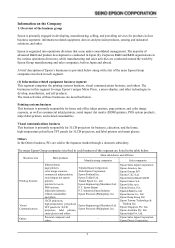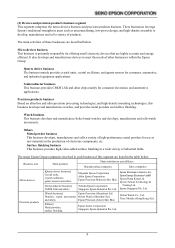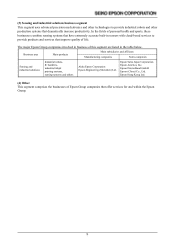Epson 2015 Annual Report Download - page 18
Download and view the complete annual report
Please find page 18 of the 2015 Epson annual report below. You can navigate through the pages in the report by either clicking on the pages listed below, or by using the keyword search tool below to find specific information within the annual report.
17
ability to procure funds, marketing power, sales skills, low-cost production ability, or other advantages to enter
business areas where we are active.
3. Sudden changes in the business environment could affect Epson.
We are laying a strong foundation to achieve sustained growth by concentrating our management resources on
the four areas of printing, visual communications, quality of life, and manufacturing, as we believe these are
areas that promise future growth and where we can leverage our unique strengths. To achieve sustained growth,
we are executing strategies based on a long-range vision and a mid-range business plan. Since we consider
technological advantage to be a critical component of competitive strength, we are driving advances in our
unique core technologies, including Micro Piezo printheads, micro-displays, sensing systems, and robots, all of
which originated from the compact, energy-saving, high-precision technologies that have been Epson’ s unique
strengths since the Company was founded. By driving advances and combining these technologies to create
platforms, we are developing and manufacturing products and providing services that meet the needs of our
customers.
However, the pace of technological change is generally rapid and product life cycles are usually short in the
product markets in which we are focusing our management resources. In addition, demand and capital
expenditure trends in Epson’ s main markets move in tandem with the global economy and could hurt demand
for Epson’ s products, and there is no guarantee that the mid-range plan and business strategies we are pursuing
will be successful.
We must understand the needs of markets and customers, and we must invest and conduct research and
development from a medium- and long-range perspective based on product market forecasts. We must also
pursue a strategy of creating development and design platforms that enable us to transition quickly and
smoothly from existing products to new products.
If we are unable to adequately adapt to changes in market needs and technological innovations, or if economic
downturns or other factors cause demand to fall and prevent a recovery, or if we are unable to adequately
accommodate sudden changes in demand in our main markets, our operating results could be adversely
affected.
4. Our revenue and earnings could be adversely impacted by sales of third-party inkjet printer
consumables.
Ink cartridges, which comprise the bulk of consumables sold for inkjet printers, are an important source of
revenue and profit for Epson. However, third parties also supply ink cartridges and other inkjet printer
consumables that can be used in Epson printers. These alternative products are typically sold for less than
genuine Epson brand consumables and are more prevalent in emerging markets compared to the markets of
developed countries.
To counter sales of third-party consumables for inkjet printers, we must emphasize the quality of genuine Epson
products and must look to continuously realize customer value by further enhancing customer convenience with
inkjet printers tailored to the needs of customers in each market. Printer models equipped with high-capacity ink
tanks are an example of such products. We also take legal measures if any of the patent rights or trademark
rights we hold over our ink cartridges are infringed upon.
However, there is no assurance that any of these efforts will be effective, and if our ink cartridge revenue
declines because unit shipments of Epson brand ink cartridges shrink as sales of alternative products expand and
as we lose market share, or if we must lower the prices of Epson brand products to stay competitive, our
operating results could be adversely affected.
5. Expanding businesses overseas entails risks for Epson.
We continue to expand our businesses overseas, and overseas revenue accounted for more than 70% of our
consolidated revenue for the business year ended March 31, 2015. We have production sites all over Asia,
including China, Indonesia, Singapore, Malaysia and the Philippines, as well as in the United States, the United
Kingdom, and other countries. We have also established many sales companies all over the world. As of the end
of March 31, 2015, our overseas employees accounted for more than 70% of our total workforce.
We believe that our global presence provides many advantages. For example, it enables us to undertake
marketing activities aligned with the market needs of individual regions. It also makes us cost-competitive by
reducing manufacturing costs and lead times. There are, however, unavoidable risks associated with overseas
manufacturing and sales operations. These include but are not limited to changes in national laws, ordinances,
























